by Justin Tejeda. Illustrated by Ella Mendoza.
Childhood Pictures


by Justin Tejeda. Illustrated by Ella Mendoza.

BY SAUL LOEB/AFP VIA GETTY IMAGES.
Amid the pandemic, a frequently disregarded portion of the GOP gained notoriety: Republican Governors. In a recent article, The Washington Post referred to Gov. Ron DeSantis of Florida (R), Gov. Kristi Noem of South Dakota (R), and Gov. Greg Abbott of Texas (R) as the “vanguard of GOP resistance to public health mandates.” As the article aptly notes, both DeSantis and Abbott have banned mask mandates, but this hardly qualifies them as thought leaders. Yet, people seem to keep referring to them as such.
Liberal news sources from The Washington Post to Vice have made Republican Governors, particularly Greg Abbott, front page news. From Abbott banning local officials from mandating masks in their regions to the announcement that he has contracted COVID-19, journalists have reported on Abbott religiously– and Democrats, nationwide, have dutifully shared these articles and infographics so everyone can watch Texas in abject horror. Unfortunately for them, that’s exactly what Abbott wants.
Okay, maybe he doesn’t want everyone to be horrified, but in a political climate where “owning the libs” is the centerpiece of the GOP’s strategy, the coverage does exactly what he needs it to.
Gov. Greg Abbott is up for reelection in 2022, and despite facing several challengers in the primary, even Democrats are sharing articles calling him a leader. With that kind of press, how could he lose? While his polling numbers are starting to dwindle, he’s winning the optics game. Even with increasing criticism from his own party, the election is still considered “Abbott’s to lose.” That assessment seems fair, considering that Gov. Abbott has raised over $55 million for his reelection campaign, more than any Texas candidate has raised in the state’s 176-year history.
It’s insufficient to just say Gov. Abbott wants attention; that can be said of any politician. Instead, there is something unique about how the governor is covered in the news that works to his benefit. National headlines about state governance typically do one of two things: prompt outrage or elicit praise. For Greg Abbott, these headlines do both, often while furthering the causes he supports.
By now, every major news outlet has reported that Abbott has contracted COVID-19. While Abbott is firmly anti-mandate, he, through personal choice, is fully vaccinated, making this a breakthrough infection. CNN declared that this experience should teach Abbott that masks work, emphasizing that should reverse his stance on mask mandates. The article acknowledges that this is a lesson Abbott is bound to ignore, but the implications of Abbott’s infection and its coverage may go far deeper than the maintenance of the status quo.
As of August 16, only 45% of Texas is fully vaccinated and less than 60% of the state has received their first dose. While Abbott has encouraged his state to get vaccinated, his efforts appeared half-hearted and failed to convince many of his constituents to get the jab. Breakthrough infections are to be expected and cases involving unvaccinated patients now make up the vast majority of deaths, but when these breakthroughs happen at the highest level of vaccine-hesitant states, the greatest negative impact will be to that state’s vaccination rates. Spreading the news of Gov. Abbott’s asymptomatic case will not change his mind about mask mandates, but it can very easily convince the unvaccinated and the partially vaccinated that they don’t need the vaccine.
The discussion of Greg Abbott’s infection often includes one seemingly key and outrageous detail: he attended a maskless campaign event the day before. However, Democrats need to consider the consequences before grabbing their pitchforks. Can crowded, maskless events (where, statistically speaking, most people are unlikely to be vaccinated) be superspreader events? Absolutely! That’s why the CDC recommends even fully vaccinated people don masks in high transmission areas. Will the mass criticism of these events followed by limited to no outbreak encourage more of these events? Again, yes. When people share messages, they amplify their reach, but it’s not always clear what messages are gaining traction. Disease spread by asymptomatic vaccinated people, like Gov. Abbott, is something that the CDC has yet to publish data on. While this is an important thing to monitor, using an unknown to drum up concern is bound to panic the Left and bolster the Right. To raise concerns and be wrong seems to be one of the most dangerous things Democrats could do as we attempt to beat the pandemic.
It’s important that people remain informed and that constituents stay critical, so this is not to tell you to stop reading and writing about Greg Abbott and other Republicans. But if you’re a Democrat (or anyone who has a vested interest in not amplifying Republican messaging), here are a few ways to not do what Greg Abbott wants:
So, yes, people have given Republican Governors what they have wanted for months. Attn: Democrats─ today is the perfect day to stop.
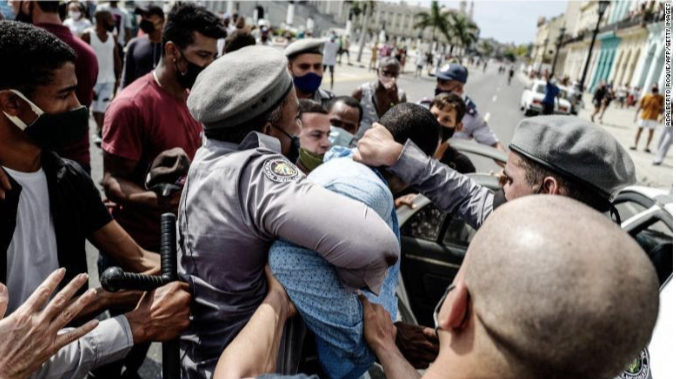
Recent protests on the Cuban island filled Western newspapers in July, including a cacophony of calls for regime change and further intervention in the socialist-led nation. Thousands took to the streets in cities across Cuba in the largest protest to have taken place since the fall of the Soviet Union, certainly the largest show of dissidence since President Díaz-Canel took power April 19th, 2018. The less covered and oft-downplayed counter-protests saw at least tens of thousands of participants, however, with the government even saying that numbers reached over 100,000 marching in support of the revolutionary government.
The protests initially broke out on July 11th and lasted for about a week’s time before petering out as the initial fervor faded. The concerns of the protestors varied, with some in the streets due to the government’s coronavirus response, lack of vaccines, an ailing economy, and disillusionment among younger Cubans. All of which are extremely valid concerns as the virus continues to rage around the globe, and while economies continue to struggle with emerging from the ever-continuing pandemic. While many of the complaints are valid, and the necessitation of the right to protest must be guaranteed, some protestors were clamoring for something that has only had disastrous effects: American military intervention and regime change. Cuban Americans in Florida have been at the vanguard of calls for President Biden to invade the Caribbean Island, on a humanitarian and regime change basis.
If history would serve correct, as it often does, American military intervention in Cuba would be disastrous to say the least. The consequences of the recent departure from Afghanistan by American and allied forces should be a clear indicator of what would become of another regime change and occupation campaign. The American role in Cuban affairs is and has historically been over-pronounced, beginning with the US occupying the nation following its defeat of the Spanish alongside Cuban rebels in the Spanish-American War (also known as the Cuban War of Independence).
The Americans would go on to invade Cuba four additional times following May 20th, 1902, when the US officially announced the end of its military occupation of the island and Cuba declared independence. The justification of the interventions varied from protecting American business in the sugarcane industry, to crushing an Afro-Cuban led revolt, as well as invading to defeat leftist insurgents although the Cuban government repeatedly declared it would handle the situation. All three situations utilized the enshrinement of the Platt Amendment in the Cuban Constitution, virtually making Cuba a protectorate of the US rather than a fully independent nation. The language of the amendment gave the US a massive amount of discretion in its enaction. Specifically, Article III required the government of Cuba consent to the right of the United States, while also allowing the US to construct what would become known as Guantanamo Bay. Not until 1934, in accordance with his “Good Neighbor Policy”, did President Roosevelt repeal the Platt Amendment, ending the repeated involvement of the US military in Cuba since 1898.
Since the rescinding of the Platt Amendment the United States relations with Cuba have fluctuated extremely: from openly working with elected officials, to supporting strongmen, assisting coup d’états, and ultimately attempting a CIA-led invasion, followed by decades of crippling sanctions. The events of the 1950’s and 60’s have been extremely influential on the relations of the two nation’s beginning first with the seizure of power by General Fulgencio Batista in March of 1952.
General Batista had already led a prior coup in 1933, toppling a provisional government which had replaced Dictator Gerardo Machado. In this revolt Batista amassed a cult of personality and rose to one of the most powerful men in Cuba, leading the nation through several puppet presidents and institutions until being elected President in 1940. Following the end of Batista’s term, he then traveled abroad and lived in the United States, investing huge sums of money he had amassed through his monopoly on political power in Cuba from 1933-1944. Batista would then find the need to return to Cuba under perceived rise in corruption and collapse of public works, running for president in the 1952 elections that were to take place in June.
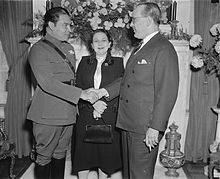
Batista, though, was not as popular among the Cuban people as he had calculated, and all indications pointed to Batista losing the 1952 elections. Prior to his defeat materializing Batista took decisive military action against the elected government of President Carlos Prío Socarras, who ironically had participated in Batista’s previous coup in 1933. Three months before the elections were to take place in March, Batista, with support of the armed forces, took over the Presidential Palace as well Havana proper in effect ousting the elected government.
While having constructed the 1940 Constitution, which by all measures was a progressive document, Batista didn’t return to its promises but instead reneged on all previously progressive positions and grew increasingly conservative in ideology and authoritarian in practice. During his 1950’s rule, Batista was incredibly corrupt, inviting American Mobsters onto the Island to run its casinos and embezzling funds from Congress, amassing a huge fortune with everyday Cubans footing the bill. Batista would then rule with the backing of the United States until being overthrown via popular revolution led by Fidel and Raul Castro alongside Che Guevara in early January of 1959.
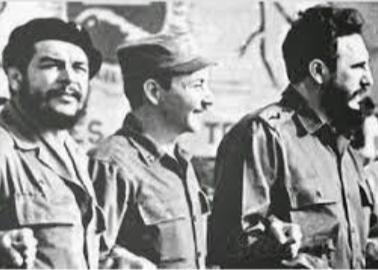
The turn of the decade─and ruling powers in Cuba─marked the greatest shift in American policy, as for years it had been one of either controlling the island or backing various political leaders, with Castro’s ascendence turning the US position to downright hostility. The ideology of the Marxist-Leninist revolutionaries was arguably the nail in the coffin for US-Cuba relations; as the latter became closer with the Soviet Union, the US grew increasingly hostile with the island. On January 3, 1961, citing “unwarranted action by the Government of Cuba that placed crippling limitations” regarding the ability for the Embassy to function, the US government officially closed its embassy in Cuba.
Shortly before closing the embassy, on October 19th, 1960, President Eisenhower authorized the partial embargo which would be the initial step toward the blockade we know today. That step to the embargo of today was made less than 18 months later on February 3, 1962, following the failed Bay of Pigs invasion, President Kennedy signed Proclamation 3447, which declared an embargo on all trade between the US and Cuba. The embargo would be strengthened a year later with the Cuban Assets Control Regulations, an economic sanction that forbade financial transactions with Cuba, cutting off Cuba from all American business and banking institutions.
Following a thaw in the 70’s under the Carter Administration, the US returned to its hardline stance under the George H.W. Bush and Clinton Administrations in the 90’s passing both the Cuban Democracy Act (1992) and the Cuban Liberty and Democratic Solidarity Act of 1996. The bills further prohibited US business dealings with Cuba, extending the ban to foreign subsidiaries of US companies, restricted remittances, and allowed sanctions against companies that invested in formerly American owned property, seized as a result of the nationalizing of Cuba’s resources and land. President George W. Bush further increased sanctions and their penalties which would largely stay in place until the re-establishing of relations under the Obama Administration.
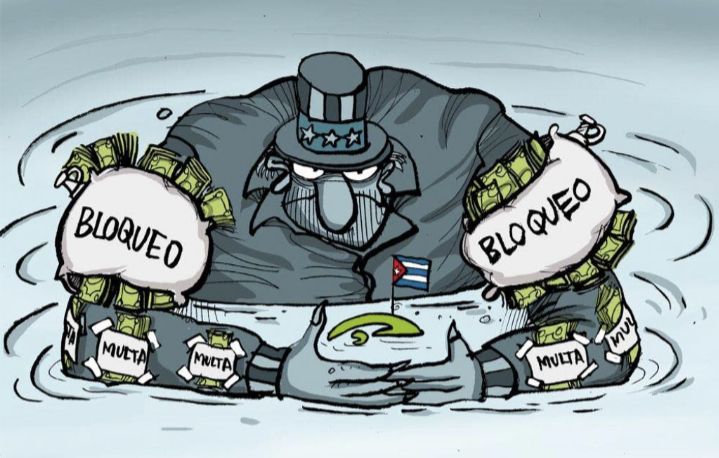
Under the Obama Administration, Cuba-US relations were the warmest since the Castro’s came to power following the toppling of the Batista regime. The pair of countries re-opened their respective embassies, while under Obama the US alleviated some of the sanctions concerning financial transactions, travel to the island, and official trade between the nations. Even with this much progress toward normalization having been made, most if not all has been lost as the Trump administration rushed to reimpose sanctions Obama had rolled back, as well as imposing additional sanctions while additionally listing Cuba as a sponsor of Terrorism – joining Iran, Syria, and North Korea.
All this history of US involvement in Cuban affairs along with the turbulent relationship between the two nations brings us back to the recent protests we have seen. Thousands of people took to the streets protesting food and medicine shortages, the handling of COVID, as well as police brutality and political freedoms. Each are more than valid reasons to protest, and such problems should be met immediately by the Cuban government. On the international stage the Cuban government has been met with widespread condemnation on the use of police and security forces to disperse protestors, as well as the arrest and detention of some protestors. To date, upwards of 700 people have been detained by the government for their role in the protests, which government officials often label as riots. While it isn’t a positive development in Cuba, it would serve the US government, international community, and media class to recall just one year ago the protests that rocked the US from coast to coast, north to south, for months.

In those protests, which were in response to an extrajudicial killing of an unarmed Black man by US Police Forces, millions, not thousands, took the streets demanding at the very least a reformation of police forces and at the most complete restructuring of power and redistribution of wealth in the nation. Of those protesting, which were also often labeled riots by government officials, over 10,000 people were arrested in the first weeks alone, while those not arrested were met with tear gas, steel-rubber coated bullets, and baton charges. Journalists were fired upon with tear gas and rubber bullets, including a reporter struck while on air, as well as another being arrested on live TV. Such a comparatively harsher response to valid protests against governmental action should be expected as a scene unique to oppressive regimes… although it was (and is) the status quo in the United States.

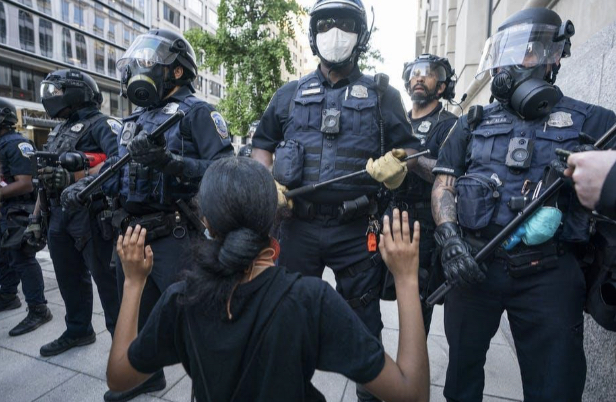
In remembering our own mass protests, and the government’s response, it seems hypocritical at best and malevolent at worst for the US to respond in such a hostile manner. President Biden issued additional sanctions on Cuba, on top of the Trump-era sanctions the President promised to rescind on the campaign trail. If our President truly wanted to aid the people of Cuba he wouldn’t have levied additional sanctions against the government, sanctions of which were designed with isolation, suffering, and regime change in mind rather than anything else. The State Department’s own documents outlined the early strategy of the US toward Cuba which would become the status quo:
“If the above are accepted or cannot be successfully countered (points detailing Castro’s and Communist influence and popularity), it follows that every possible means should be undertaken promptly to weaken the economic life of Cuba. If such a policy is adopted, it should be the result of a positive decision which would call forth a line of action which, while as adroit and inconspicuous as possible, makes the greatest inroads in denying money and supplies to Cuba, to decrease monetary and real wages, to bring about hunger, desperation, and overthrow of government”
Memorandum From the Deputy Assistant Secretary of State for Inter-American Affairs (Mallory) to the Assistant Secretary of State for Inter-American Affairs (Rubottom)
Washington, April 6, 1960.
Considering the historical positions of the United States, its own documents, and the continuity of strategy across the Trump-Biden presidencies, I find it hard to believe the United States has a moral and political upper hand with Cuba as the former often postures. That sentiment was borne out in the international community in a recent UN vote that blasted the continued embargo of Cuba with the General Assembly voting 184 in favor of a resolution condemning the blockade. Only two nations voted against, predictably the United States and its hardline ally Israel, after voting with the US in 2019. Brazil chose to abstain from the vote, as did US allies Colombia and Ukraine. This rendition of the resolution calling for an end to the embargo has now been passed by the UNGA 29 times since 1992.
To truly help the Cuban people, the United States must come into compliance with the vast majority of the world, as well as its allies, and end the embargo of Cuba while rescinding relevant sanctions. The “economic warfare,” as the Cuban foreign minister puts it, has no place in American diplomatic efforts. They haven’t worked in most cases─Cuba, Iran, North Korea, and Venezuela─where they’ve all been employed to enact regime change. The reality on the ground is that these measures hit the people the US claims to want to help the hardest. It’s time for the US to end the embargo, render aid to Cubans in need following normalization, and then diplomatic efforts can proceed. Historically, as ties have warmed, so has the Cuban Government often softened its stance. In 2021, after all the suffering we’ve seen in this pandemic, we must do the objectively correct thing and end Cuba’s isolation, for it’s their suffering that our diplomatic polices exacerbate.
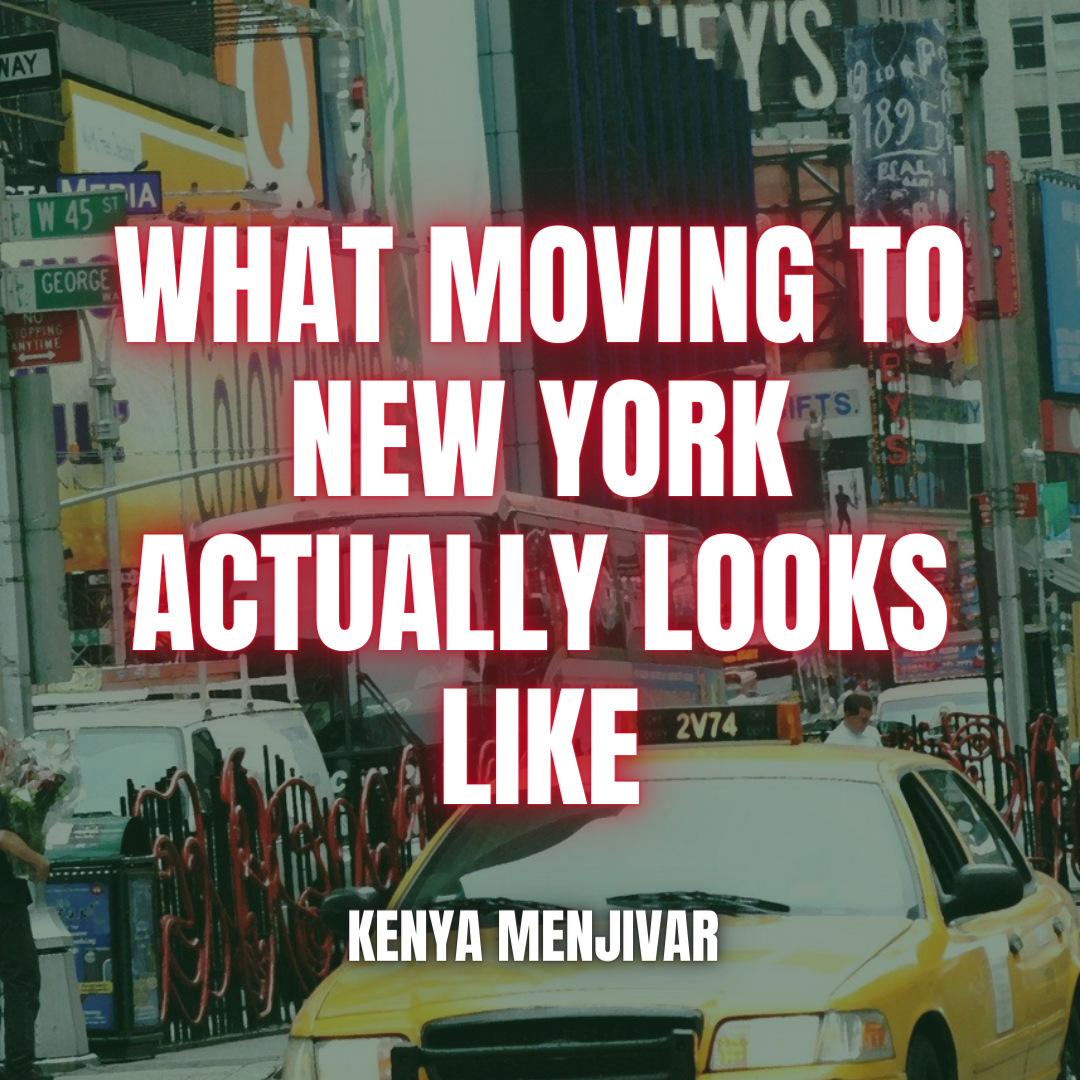
I’ve always imagined the journey from Texas to New York to be a glamorous and exhilarating move–like the ones you see on television. Gossip Girl and Sex in the City gave me high hopes.
And although the move has been exciting–insane driving, cars honking every second and face sized bagels–my move was not as glamorous as the T.V. shows let you think.
If you asked me five years ago, I would say I now would be living in a small, brick covered apartment in Brooklyn, watching the commuters dash towards the subway station from my window as a full-time writer. But as reality hits me in the face, I live in the mystery of Long Island, with an hour train ride from the city. A place that could not be more at odds with Manhattan.
Five years ago I was a senior in high school hoping to attend the historical New York University. But after realizing the tuition was over 100,000 yearly and getting rejected, my hopes were against me. I attended a local college in Texas and finished in three years, counting down the days until I was able to make the big move. As I trudged against the stage during my early college graduation ceremony, I clung to the excitement of my life after college.
But that, too, wasn’t like I had imagined it. I moved back home (raise your hand if you did to save money on rent?) risking the state of my mental health for a year and a half. And now here we are, living on the border of Suffolk and Nassau county.
Long Island is spacious. It’s filled with suburbs, families everywhere, Main Streets in every town and, of course, only a 10 minute drive from the beach. It’s not a bad choice. It is the cheaper choice however, especially for a person in her early 20’s, who is still trying to figure out her life after college. And with a degree in journalism, the competition is immense.
Rejection and interview after interview, I still stand living 1,500 miles from home.
See, it’s easy to dream of your future and all the desires you have for the hypothetical life. And even though I am still a dreamer and a loyal futuristic thinker, I do have to face reality.
It’s like Rory from Gilmore Girls, she dreamed and dreamed about going to Harvard and ended up going to Yale. I dreamed and dreamed of moving to NYC and have moved to the outskirts, but like Rory I made a decision that benefitted me and would help put me on the path I wanted to take.
Facing reality means that I am a part-time barista, working to make ends meet. Barely having time to hone my own craft, fighting against the hours in the day.
But in facing reality, I can give myself a pat on the back for even taking the leap to move to the overpopulated state.
Although I do not live in the city–yet–I do live in New York. I drove the 26 excruciating hours, through the pitch black night in Arkansas and through the corn fields of Illinois. And let me tell you, those fields went on for days. We took a breather in Ohio but quickly sped away the next morning, finally making it to the city of wonder. My mom is amazing.
Now, I speak to you after experiencing almost two months in New York. Although the journey may have been a different and a second choice, I can’t leave you thinking I am anything but proud of myself. You, too, may be wanting to move to the city that never sleeps and I encourage you, follow your dreams. But I must warn you that the journey may not be as captivating as the youtubers make it seem. There are rough patches and that is OK.
You won’t have your close friends only a drive away. You won’t have the familiarity of the roads from home. You won’t have the safe box you’ve lived in your whole life.
But: you will have adventure. You will have new friends. You will have excitement. NYC is slowly coming back to life (kind of, post pandemic) and it is available to you.
Everyone’s journey is different, and my desire is that by sharing a glimpse of my journey you don’t feel alone. Your journey, if you take the risk, could be beautiful and it will most importantly be your own.

Helicopters touching down on the roof of the embassy in Saigon and evacuating American personnel—along with very few allied South Vietnamese—was the scene precipitating the American pullout of forces from Vietnam. It seems those optics are destined to repeat themselves in America’s latest foray, as Afghan National forces are quickly and steadily overpowered by the Taliban on the heels of an American pullout from its longest war.
For one to label the Taliban’s recent advance across Afghanistan as swift would understate the complex web of logistics and troop movements at play. Between the two, the Taliban is under-equipped and outmanned compared to the Afghan National Defense Forces. The Afghan National forces also boast an Air Force, with the Taliban’s most advanced aerial capability being unmanned drones. These facts only beg the larger question of what exactly is happening in the South Asian nation, why the armed forces are collapsing, what is the government’s plan to respond, if one exists, and, frankly, how long will the Afghan government and Kabul remain in place?
The decision to withdraw American and allied troops was announced by President Biden in April, with plans for nearly all foreign forces to be out of the country by September; four months later than the plan originally negotiated by former President Trump. The Taliban, for their part in accordance with said deal, pledged not to attack foreign forces as they prepared for withdrawal, though Afghan National Forces were not part of that moratorium on violence. Directly following the announcement by President Biden of the departure of foreign troops, the Taliban began their current offensive.
The armed group began their assault, tearing through the traditionally insecure rural swathes of Afghanistan, slowly encircling provincial capitals and seizing border crossings in the progress. Early signs of the coming collapse of the Afghan Army came in the falling of the Islam Qala border crossing with Iran, as well as the Spin Boldak crossing with Pakistan. The Islam Qala district and border crossing fell to the Taliban on July 9th, with customs and government officials fleeing into neighboring Iran. This came mere days before the Taliban’s seizure of another key border post, Spin Boldak, on the border with Pakistan, on the 14th of July. It’s estimated that tens of millions of dollars ($) worth of trade come through the two ports each month.
The seizures came amid numerous reports of Afghan military personnel and police fleeing ahead of Taliban advance by the thousand. The Taliban, in the earlier weeks of the offensive, seemed intent on strangling the central government by quickly taking border crossings, undermining the government’s ability to finance their troops while filling Taliban coffers. The prospect of losing rural districts to advancing Taliban forces was expected following the exit of foreign forces, although the bitter string of defeats, cross-border retreats, and loss of border crossings had to serve a debilitating blow to the morale of Afghan National Forces as well as handicapping the economic capabilities, strategic maneuvering, and supply routes of the Kabul Government.
The losses of the Kabul government were quickly written off by Western allies, as a predictable consequence of the retreat of foreign forces. The Taliban’s troop movements and attack strategy have been extremely calculated, first taking swathes of rural territory to facilitate supply lines, moving then to take strategic border crossings, and most recently the encircling and assault of provincial capitals. The strategy follows a line of encirclement, then of strangling the central government into submission. Highlighting the steady loss of territory to the Taliban is the tally of districts under its control: on April 13th, the day of the announcement of the withdrawal of foreign troops, 194 districts were contested, 129 under Government Control, and only 77 under control of the Taliban. Today, as is depicted below, the Taliban control 247 districts, 97 are contested, with the government in control of only 63, including Kabul at the time of this writing.
The outset of August proved to be the busiest time for the armed group as the they had for the most part completed its strategy of encircling provincial capitals, often taking surrounding districts with little to no resistance from Afghan troops. At this point the only recourse for the government had been to attempt to mobilize anti-Taliban public volunteer “uprising forces” in effect boosting the manpower and resistance the ANSF can project. Even this though hasn’t proved to slow down the group as the Taliban have amassed more territory than the group has held to date, bolstered by the gains of their blistering August offensive.
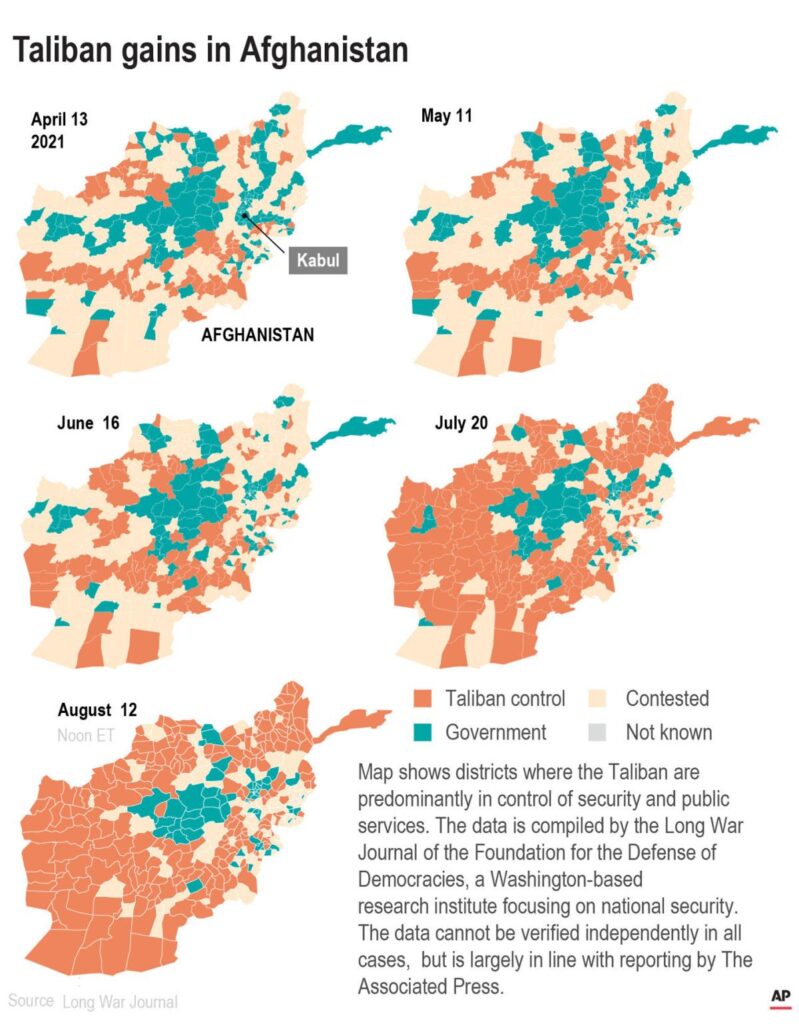
Focusing solely on the actions in August, we see a group that seems to far outmatch the government forces, albeit outnumbered, it is a reach to now say the Taliban aren’t armed similarly to the ANSF considering the amount of territory, cities, and bases the Taliban have taken. With the previously mentioned tactic of encirclement in mind, the Taliban invoked their next phase, seemingly of choking off the government from controlling provincial capitals, while continuing to isolate Kabul. In doing so, the Taliban took their first provincial capital on August the 6th, seizing Zaranj, the capital of Nimroz province. This seizure served as the writing on the wall for defending Afghan government forces as by the end of the week on the 8th, the Taliban had captured and were administering four provincial capitals, including Sheberghan and Kunduz, major cities in the oft-restive Northern region. During the Taliban’s time in power during the late 90s and early 2000s the provinces in the Northern region came together in the anti-Taliban “Northern Alliance”, almost the entirety of the former bastion of Taliban resistance has been seized by the group, with Sheberghan and Kunduz being the key cities to fall in the region.

The momentous advance of the Taliban has yet to be stopped by government forces, from seizing their first capital August 6th until the writing of this article, the early hours of August 14th, the former has seized 20 provincial capitals, a majority of the 34 provinces. On Saturday morning the 14th the Taliban began a multi-pronged assault to take the last government held city in the North, Mazar-i-Sharif, as embattled President Ghani pledged to keep fighting.
The armed group continues to put pressure on Kabul as well, albeit indirectly, as the group has taken the second and third-largest cities of Herat in the West and Khandahar in the South. In a more direct move, the Taliban on the morning of August 14th seized Logar province and had begun to enter the Char Asyab district located just 7 miles south of Kabul. The attacks by the group on heavy populated areas such as Herat, Khandahar, as well Lashkar Ga of the strategic Helmand province are especially dangerous to civilians, as extremely confined urbanized warfare leads to higher civilian casualties. According to a United Nations report, civilians’ casualties have returned to a 2017-2018 peak of over 5,000, with newly renewed violence being the culprit, of the 5,000+ casualties, 39% were attributed to the Taliban, with 25% being attributed to pro-government forces, often via airstrike targeting anti-government forces.
The prospect of urban fighting, including airstrikes inside the city of Kabul, had been an absurd scenario only months ago, although now considering recent gains seems a more and more likely scenario. As more and more land, provincial capitals, and infrastructure fall to the Taliban, the prospect of Kabul as a reprieve from direct conflict is no longer the reality on the ground. In direct response to these territorial losses and in fear of what may happen over the span of the next few days, the Americans as well as some other European countries are sending thousands of troops to Kabul to assist not its defense, but their retreat from the embattled capital. The New York Times reports that an additional 3,000 Marines will be sent to Kabul, with another 4,000 stationed in Kuwait on stand-by. While only American personnel will be evacuated, the United States has been attempting to arrange third-party nations to host translators and other Afghans who assisted the coalition; it is unclear what, if anything, is keeping Biden from simply accepting those who assisted US forces on a humanitarian and asylum basis into the United States immediately.
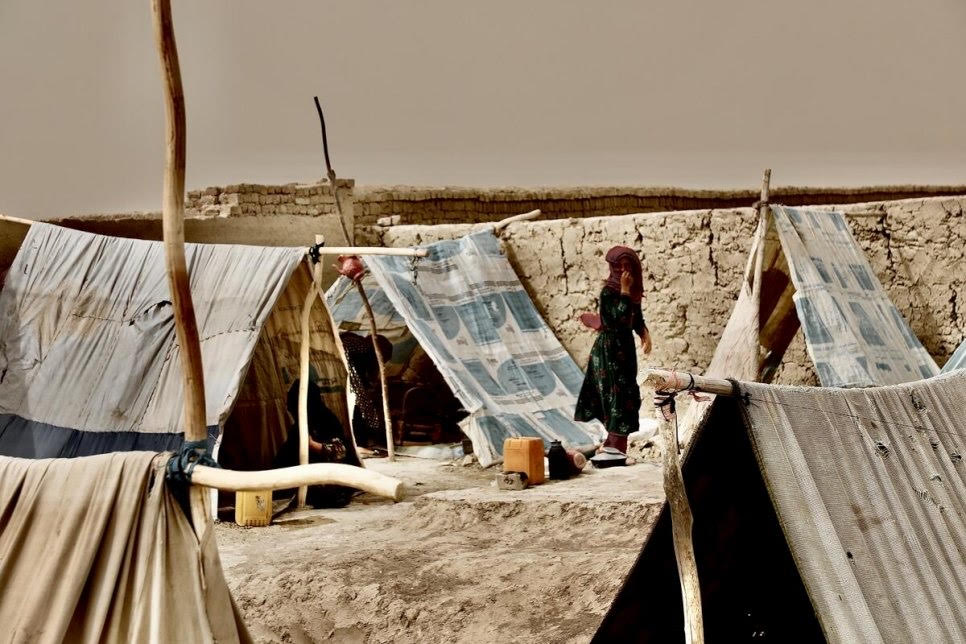
At the time of writing over 400,000 people have been displaced in Afghanistan since the beginning of the year, joining the almost 3 million Afghan people already internally displaced due to fighting. The UN estimates that 250,000 have become displaced since the beginning of the Taliban offensive in May, with some 80% of that number being women and children fleeing fighting. Clean water, food, and shelter are hard to come by amid the deteriorating security situation, and very few places, if any are free from fighting.
This all comes amid the American withdrawal from the War. What was the reason for our being there? What did we gain? Who did we help? As Americans we might ask ourselves these questions, as we should always question our government’s actions. The answer is a painful nothing and no one. To be privileged enough to ask what we gained is indicative of the differences of power and suffering in the United States’ longest running conflict. The Afghan people suffered mightily for 20+ years of War between foreign forces allied with the government and insurgents, only for foreign forces to create a security vacuum following their hasty retreat. Questions must be asked of the feasibility of the Americans’ occupation in the first place, did the short-sightedness of conquering a lesser military in the Taliban cloud the complications of forming a working government that served all Afghan people. Why was the security situation as insecure as it was prior to announcing a withdrawal, why was the situation stagnant for years? Most of our questions will forever remain as they are, questions, one thing is certain though, Kabul will eventually come under direct pressure and will in all likelihood fall in the coming days and weeks rather than weeks and months. Continued suffering of the Afghan population writ large is certain.
One must wonder what the South Vietnamese thought as they saw the last American helicopters abandon them to the advancing armies of the North, one must wonder why 46 years later the American imperial military machine has made the exact same mistakes. Most of all one must wonder why Americans have allowed this practice of military intervention, further destabilization, and retreat to ravage many a country and civilian population. Another thing is certain, this destructive practice cannot continue, in perpetuity military adventurism has historically caused the fall of empires, continuing down this path, the United States could be the next.
Updated August 14th 1:23PM EST: Capital of Balkh Province, Mazar-i-Sharif, has fallen to the Taliban. Mazar-i-Sharif was the last major city remaining under Government control in the Northern region.
Updated August 15th 1:21PM EST. President Ashraf Ghani flees to neighboring Tajikistan as Taliban fighters enter Kabul.
Updated August 15th 3:58AM EST: Taliban fighters seize Jalalabad last Government controlled city outside of Kabul, completely encircling the capital.

This photography piece demonstrates how contemporary art works go about discussing topics in highly conceptual ways that examine the interwoven cultural nuances.



pictures, good pictures, wondering if they mean much to me or much to anyone else for those they capture are mine the pieces of my puzzle no one else but me was there behind the lens behind the bends of the breaking backs moments crashing causing tidal-waves of feeling i am present in some absent in all the continuity is palpable years of flicks and flashes picking passages of time to document i hope someone sees these and feels that they too are present though they are not i hope that those that are present feel omnipresent almost godlike looking upon themselves it is not a mirror but the peering through the looking glass the poormans timemachine bring me back to the time that i found you and you and you all gathered in my kitchen so present so pleasant so candid and genuine i know they are gone but they are here all here all peering into the present to see how far youve come i hope when you look upon them you do not see flaws and imperfections i hope you see light and genuine perception this is the closest we will get to seeing ourselves through another’s eyes do not see this as some surprise i have loved you for so long the songs that play they echo through the day through the glass it passes from lens to lens from ass to end from pig to pen and now to then i see you. perfect and crystalline. just as i left you. i hope you can find me. i hope i am just the same. and if not. i hope it is in the ways that never mattered.
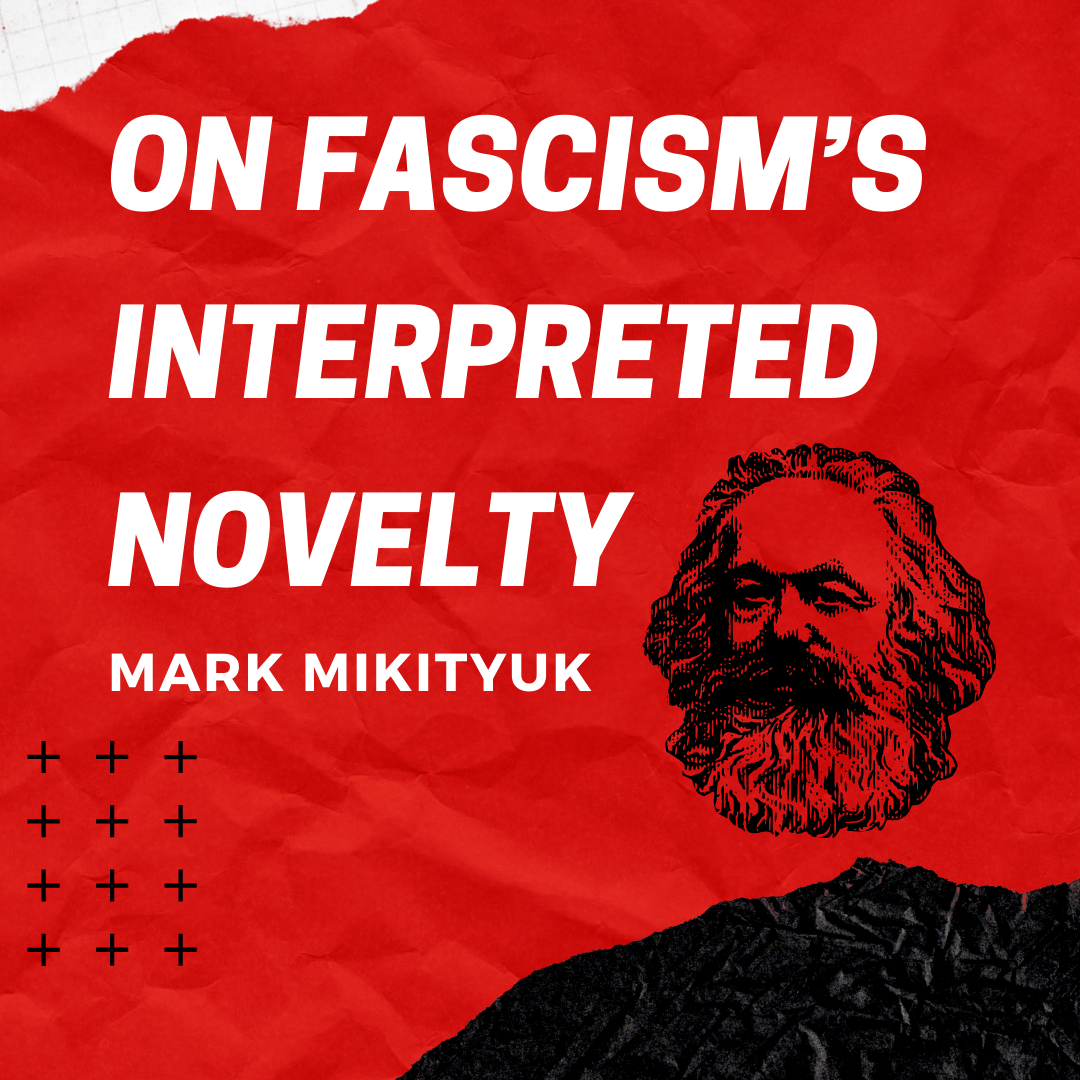

by Sam Adams
Following the fall of the Soviet Union, Viktor Orban presented himself to the Hungarian people as the harbinger of a new time, railing against any vestiges of Communism in the former Soviet state. Clinging to the reactionary rhetoric of anti-communism and championing liberalism Fidesz underperformed in its first initial showings in the 1990 and 1994 Parliamentary elections, leading Orban and its leadership to take a more conservative turn ideologically. The solution as Orban saw it was to move from a liberal centrist party to a center-right party, while forming alliances with parties almost solely on the Hungarian right. The announcement came at the 1993 Party Conference, in consequence many of Fidesz leaders split from Orban and the proposed rightward shift, leaving Viktor Orban as the party’s unrivaled front man.
The subsequent elections following the re-orientation of Fidesz in 1998 saw surprising success as the Party received slightly less votes than the Socialist Party although Fidesz received the most seats in Parliament due to the allocation of seats at both a regional and national level. Fidesz joined in a governing coalition with two other center-right and right wing parties, due to the mandate being an extremely small margin, the government could not implement any sweeping changes.
Lacking any real legislative power to effect changes with their fragile 1998 majority Fidesz would fail to return to a majority in 2002 and would be relegated to the opposition until 2010. Due to a change in Party politics, Orban was forced to step down as the leader of Fidesz while Prime Minister in 2000; returning to Party leadership following the 2002 loss of the Premiership to the Socialist Party and its liberal governing coalition. Following subsequent failures to capture the reins of government in 2006 Parliamentary elections, Orban faced pressure to step down as the face of Fidesz. Reprieve from calls for his resignation came only when it was revealed in a closed Party meeting that the governing Socialist party had lied to the nation specifically with respect to the state of the economy and more broadly the Hungarian nation’s interests in order to retain votes. The infamous speech known as the Oszöd Speech would upend Hungarian politics and led to massive street protests and marked a nationwide, if not continent wide tarnishing of the Hungarian Socialist Party (MSZP); the speech hamstrung Fidesz and Orban’s greatest political adversary paving the way for a return to power for the latter.
The elections that precipitated the Oszöd Speech would have far reaching ramifications, with Hungary’s political landscape completely remade following the scandal as well and the 2008 financial crisis. Seizing on the Socialist Party’s growing unpopularity and corruption and while weaponizing high unemployment following the 2008 economic crisis Orban and Fidesz positioned themselves at the forefront of the polls, while the far-right Jobbik Party saw a bump in popularity as well. The results in the 2010 Parliamentary elections saw a stunning capture of a super majority by Fidesz, passing an important interval that would allow the party to freely make constitutional changes. The results were particularly shocking considering the shares of seats lost by the Socialists, diving down from 192 seats in 2006 to a meager and legislatively powerless 59 seats in 2010. This underscored a truly full-fledged collapse of the Socialist Party in Hungary, forcing the former political hegemon to scramble to form any meaningful opposition to Orban while attempting the process of repairing the party and organizing for future elections.
Upon his ascension back to the top of Hungarian politics Orban began to ensure and insulate his power, undermining the nation’s long fragile democratic institutions. One of the first actions Orban took was to rewrite the 1989-90 Constitution that was authored following the dissolution of the Soviet Union. The changes enacted by the re-authoring of the Constitution sparked outrage among civil liberty groups, NGO’s, the EU, as well as the United States; some of the most controversial changes include restrictions on the media during election campaigns, limits the power of the Constitutional Court, lowers retirement age of judges, as well as dictating the state show “preference” to “traditional” family relationships. Some of the most impactful when it comes to the state of democracy in the country came with the changes to the Constitutional Court, as well as the limitations imposed on the media during campaign season. Those restrictions on media stated that only state-run media may campaign for politicians, an insular policy for Fidesz to monitor the media while only allowing pro-Fidesz literature and advertising in attempt to ensure the ruling party maintained its grip on power. With reference to the Constitutional Court, Orban modeled his takeover after that of Turkish autocrat Recip Tayyip Erdogan. Both men in seeking control of the highest judicial institution in their respective countries expanded the number of court members, packing new seats with members explicitly loyal to the executive rather than the democratic process in the two nations. Confusing critics and possibly in a move to dissuade international criticism both men also expanded the criteria for cases making it to the Constitutional Court, were the budding autocrats supporting the Court by adding new members coinciding with a greater caseload, or was the court-packing solely to undermine the Court’s ability to check the Executive?
Outside of the rewriting of the Constitution and augmenting it’s specialized Court, Orban and Fidesz launched a concerted attack on the nation’s democratic institutions such as the judiciary, the press, the election commission, as well as the tax service. Part of Orban and Fidesz’s attack was to load the judiciary, tax authority, and election commission with party/Orban loyalists in attempt to subvert the institutions obligation to democracy, re-orientating it to rather protect Orban and the Fidesz Government. Furthermore, Orban initiated a system of control over local government modeled after a Putin policy in Russia known as a “vertical of power”, Orban’s variation included the centralizing of some local government functions via the newly written Constitution as well as Orban handpicking allies and party Loyalists as local governors.
Lastly an element of the decaying of democracy and rule based law comes the demonization, discrimination, and harm done to minorities in Hungary. Two groups in particular have been targeted by Orban and Fidesz in order to rile up support among their center to far right base, those being migrants fleeing conflict in the Middle East and North Africa as well as the LGBTQIA+ community. During the refugee crisis that the greater-EU faced during the mid-late 2010s Orban and his Party took an extremely hard line against migrant quotas proscribed by the EU to it’s member states, all the while demonizing refugees and migrants as terrorists, as well as describing those fleeing violence as individuals trying to overturn the predominance of Christianity in the EU and greater Hungary. Orban went so far as to erect 4-meter high fences along his nation’s border with Croatia and Serbia in order to stem the flow of migrants seeking the EU all the while describing the refugees as “poison” and asserting his nation didn’t want or need “a single migrant”.
More recently Orban has drawn the specter of the EU and drawn international condemnation for his Party’s recent passage of a set of laws that rights groups and the West have described as discriminatory towards the LGBTQIA+ community. The law mimics a set of discriminatory laws put forth by Russia, and can be considered the “banning of gay people from featuring in school educational materials or TV shows for under-18s”. The newly passed laws have already spurned concern within the already oft targeted community, casting a dark shadow over a recent drag competition, in which a contestant said, “We are afraid to get on the tram. When we do so, we put our hands in our pockets to hide our painted nails. We have always done this, though”. The outrage was such that at this year’s delayed 2020 European Football Championship the mayor of Munich, the location of a Germany v Hungary match, asked UEFA, the competition’s governing body, for permission to light the stadium up in rainbow colors. The request was denied by UEFA who claimed to be staying “politically neutral” on the matter, missing the point that neutrality on this issue is siding with discrimination. The mayor of Munich plans to instead light the entire city up with rainbow colors and flags in protest of the Hungarian law as well as UEFA’s compliance.
While the politics of a football match are leagues away from democratic backsliding, the collective outrage from the international community, corporations operating in Hungary, the EU, and rights groups is positive, and the pressure must be continued. Orban and Fidesz have laid bare the fragility of democracy and demonstrate that if an EU and NATO member can participate in democratic backsliding and the undermining of institutions then it can happen anywhere. Democracy is a constant work, taking it for granted is a privilege, and ignoring warning signs of institutional decay and backsliding can and will have wide reaching ramifications for the future.
